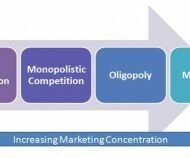Posted by Managementguru in Business Management, Marketing, Principles of Management
on Mar 4th, 2014 | 0 comments

Market Structure and Pricing Decisions- An overview What is Market Structure: It is the makeup of a particular market like different characteristics, size, value, number of providers etc. Business markets are always dynamic in nature and influenced by the number and size of potential buyers and sellers, which in turn affects the pricing of a product. If the price is set too high, say, in a homogeneous market, the firm will not be able to survive and compete with other suppliers in the market. If the price is too low, it will not be sufficient enough to cover the profit margin. If you are a monopoly player, then you are the price maker and the price you fix goes unchallenged. First let us have a glimpse on different kinds of market structure and their effect on determining the price. Four different market structures are identified. Perfect Competition Consists of huge number of buyers and sellers, each too small to affect the price of the product-sellers are “price takers and not price makers.” Homogenous products Easy entry and exit to and from the market Agents have perfect knowledge about market conditions. Here, the product is totally undifferentiated and the sellers always sell their product at market determined prices. Otherwise, they fail to attract their customers. Price cutting becomes unnecessary as producers can sell their total output at market price. Online Marketing Monopoly Only one seller in the market Factors prevail that stops other firms from entering into the market, such as, exclusive government license, access to natural resources, patent holding, being a pioneer in the field etc., The product is highly differentiated from other goods There must be no good substitutes Monopolistic Competition Has elements of both monopoly and perfect competition Resembles monopoly in that, product of individual firms are slightly differentiated from others and does not serve as a perfect substitute Resembles perfect competition, in the sense that, there are a large number of sellers and the action of one does not have any effect on the other The difference lies in the fact that sellers have some control over price fixing as some customers might be willing to pay a slightly higher price if the products are differentiated from the competitors. Oligopoly Involves unspecified number of buyers Only a small number of sellers exist The actions of each firm affect the other sellers in an oligopoly market Products are homogenous or differentiated To persist in the long run an oligopoly firm has to do something that prevents the entry of new firms into the market, either in the form of product differentiation or clever advertising. Price cutting or increase affects the sales of other firms too and so the sellers must be cautious of this interdependent characteristic of the market structure. Social Media Marketing A clear idea and analysis of the market structure in which the firm operates, target customers, size of the firm and knowledge about competitor strategy as well as general trend of the market is helpful in formulating appropriate strategies regarding pricing and promotion of your...

Posted by Managementguru in Economics, Financial Management, Sales
on Feb 14th, 2014 | 0 comments

Demand and Supply in Different Markets Demand Criteria Since the analysis of a business firm is central to managerial economics, we are primarily interested in the demand for a commodity faced by a firm. The demand for a commodity faced by a firm depends on the size of the market, industry demand for the commodity, the form in which the market is organized and the number of firms in the industry vying for the same set of resources and customers. Demand Curve The market demand curve for a commodity shows the various quantities of the commodity demanded in the market per time period at various alternative prices of the commodity, while holding everything else constant. The curve is negatively sloped, indicating that price and quantity are inversely related. The things held constant in drawing a market demand curve for a product are the number of customers in the market, consumer’s income, the prices of related commodities and tastes. Types of Markets Monopoly and Perfect Competition Coming back to the form of a business firm, at one end there exist the monopolist (the sole producer of a commodity for which there are no good substitutes), and at the other end, perfect competition, where there are a large number of firms producing a homogenous product and each firm is too small to affect the price of the commodity by its own actions. In such a case, each firm is a price taker unlike the monopolist who is a price maker thanks to the product exclusivity factor. Oligopoly In oligopoly there are only a few firms in the industry producing either a homogenous or differentiated product. Since there are only a few firms, the pricing, advertising and other promotional behavior of each firm greatly affect the other firms in the industry and evoke imitation or duplication. We witness many industrial giants fighting for their market share in the respective industrial domains. Monopolistic In monopolistic competition, there are many firms selling a differentiated product. As the name implies, monopolistic competition has elements of both competition and monopoly. The monopoly element arises because each firm’s product is somewhat different from other firm’s products that facilitate the firms to have some degree of control over the price. Although we try to establish an inverse relationship between price and demand, the other side of the coin shows a different picture in that, as the income levels of a consumer is on an increasing trend, his or her purchasing power increases. Consumers tend to purchase more of most commodities like automobiles, housing, travel and so on, when the income rises. There are some goods, however of which the consumer purchases decline as income rises- for example, maize and similar cheap foods as the consumer has the power to buy goods with better quality and there is no need for a compromise. Demand is one of the most important aspects of managerial economics, since a firm would not be established or survive if a sufficient demand for its product did not exist or could not be created. A firm could have the most efficient production techniques and the most effective management, but still without a demand for its product that is sufficient to cover all production and selling costs over the long run, it simply could not survive. Demand is thus essential for the creation, survival and profitability of a...




